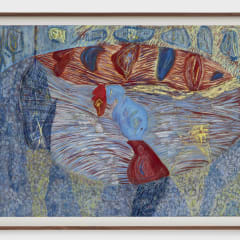Consequential Landscapes Mimi Lauter
While on the surface Lauter’s compositions and colors are very much inspired by the natural world around her, in particular by her garden, which she tends to with great love and care, the artist uses this as a springboard for a deeper reflection on painting as a theatrical space in which she can present imagery, form and narrative. “I’m always attracted to the framing of a work, almost like curtains, or some kind of architectural structure. A painting is a theatrical space, so you are gearing the viewer for an event that is taking place in front of them. It’s artificial but also a reflection of the world around you,” Lauter says.
Questions of artifice and presentation led the artist to consider the inherent tensions between landscape and still-life, two of the most historically charged styles of painting. “I think that still-life is very theatrical–the stage is set–whereas landscape is the opposite of that. I was battling with the idea of the structure of a landscape in which the image extends beyond the painting, capturing something bigger,” she explains. If still-life is a metaphor for mortality, then landscape is a metaphor for life’s journey. For Lauter, the merging of these two types of painting allows them to exist simultaneously “in the way that your sense of mortality is ever-present as you meander through life”. The environment of the artist’s garden took on a further metaphorical significance for her as her interaction with and experience of it was heightened by the global lockdown, inducing Lauter to deeper contemplations while stuck in her home for several months at a time.
Suspended somewhere between still-life and landscape, between the internal and external worlds, Lauter’s works position themselves as modern-day religious experiences. “I look at art history from a very Western perspective and in conjunction with the history of Catholicism, in which celestial landscapes look over everything,” Lauter says. “My work is totally secular, but it has everything to do with the origin of European painting. Painting was used as a tool to ignite passion and feeling in order to convince people to believe in something. That is ultimately the power of a painting–it can induce so much passion and feeling that one can be swayed into believing in something. In the world of painting, our logical thoughts and ideas are directly related to feeling.” From the experience of an imposing and overpowering stained-glass window to intimate illustrations in medieval prayer books, the strength of Lauter’s work is dictated not by scale but by intensity. Moreover, the humanist or “natural” (i.e. non-religious) quality of her pieces uses a visual language that pays homage to Lauter’s admiration for Odilon Redon, Édouard Vuillard, Pierre Bonnard and the fin-de-siècle French artistic current of the Nabis, whose kaleidoscopic use of iridescent pastel colors became a hallmark of their style.
“I’m representing something that is not always so easily articulated and that can sometimes be fleeting. My paintings are the process and the experience of going through these paths – the expansion and contraction of a walk through the garden; this is not plein air painting,” Lauter concludes.






















